How much food should i feed my cat! Feeding your cat the right amount of food is essential for their overall health and well-being. Many cat owners wonder how much food to give their cats to maintain a healthy weight and ensure proper nutrition. In this article, we’ll explore the answers to key questions about how much food cats need, including the balance between wet and dry food, portion sizes, and the specific needs of your cat. Let’s dive in!
How Much Food Should a Cat Eat in a Day?
Feeding your cat the right amount of food each day is crucial to maintaining their health. On average, an adult cat should consume around 20-30 calories per pound of body weight per day. This means that a 10-pound cat typically needs 200 to 300 calories daily, depending on factors like age, activity level, and metabolism. Cats with higher activity levels, such as outdoor cats, will require more calories, while indoor cats might need fewer due to less physical exertion. Additionally, the balance between wet and dry food impacts daily food requirements since wet food contains fewer calories than dry food.
For instance, dry food is calorie-dense, and if your cat consumes too much, it may lead to overfeeding, while wet food provides hydration but fewer calories. Therefore, adjusting the amount of food based on your cat’s preferences and nutritional needs is important. Always consult your vet to determine the ideal portion size based on your cat’s specific needs, especially if they have special dietary requirements or health conditions.
Key Points:
- Adult cats need about 20-30 calories per pound of body weight daily.
- A 10-pound cat requires around 200-300 calories a day.
- Cats’ activity levels and health status affect their food intake.
- Wet food and dry food provide different caloric values, requiring balance.
- Consult your vet for tailored advice based on your cat’s needs.
Determining Your Cat’s Daily Caloric Needs
To determine how much food your cat needs each day, start by calculating their daily caloric intake. Cats need about 20 calories per pound of body weight. For instance, if your cat weighs 10 pounds, they would require approximately 200 calories a day. However, several factors can affect this baseline, including your cat’s age, activity level, and overall health. Kittens, for example, require more calories due to their rapid growth, while older or sedentary cats may need fewer.
Outdoor cats, who tend to be more active, typically need more food than indoor cats. Furthermore, neutered or spayed cats may require fewer calories due to changes in their metabolism. You should always monitor your cat’s weight and adjust their food portions accordingly. Consulting a veterinarian can help determine your cat’s exact caloric needs and provide guidance on portion sizes to maintain optimal health.
Key Points:
- Cats generally need 20 calories per pound of body weight daily.
- Kittens need more calories for growth, while seniors require fewer.
- Active outdoor cats have higher caloric needs than indoor cats.
- Neutered or spayed cats usually have reduced energy needs.
- Adjust portions based on your cat’s weight, activity, and health.
Is 1 Cup of Cat Food Too Much?
Whether 1 cup of cat food is too much depends on your cat’s size, activity level, and the caloric density of the food. Dry food typically contains 300-400 calories per cup, so feeding your cat a full cup of dry food could exceed their daily caloric needs, especially for a smaller or less active cat. For instance, if a 10-pound cat requires only 200-300 calories per day, one cup of dry food may be too much.
Overfeeding your cat can lead to obesity, which increases the risk of various health issues such as diabetes, joint problems, and heart disease. To avoid this, it’s essential to measure food portions carefully and follow the guidelines provided by the manufacturer. If you’re mixing wet and dry food, you should reduce the portion of dry food to maintain a balanced caloric intake.
Key Points:
- Dry cat food contains 300-400 calories per cup.
- A 10-pound cat may require only 200-300 calories daily.
- One cup of dry food could be too much for less active cats.
- Overfeeding can lead to obesity and other health problems.
- Measure portions and adjust based on your cat’s needs.
Adjusting Portions for Cat Size and Activity
A cat’s activity level and size greatly influence how much food they need. Smaller or less active cats require fewer calories, while larger or more active cats need more. For example, a small indoor cat might thrive on 150-200 calories daily, while an outdoor cat that regularly exercises could need closer to 300 calories.
It’s important to adjust portions based on your cat’s energy expenditure. Too much food leads to weight gain and potential health issues, while too little can leave your cat malnourished. Pay attention to your cat’s weight and consult your vet if you notice significant weight changes or if you’re unsure about the right amount of food.
Key Points:
- Smaller, less active cats need fewer calories, while larger, more active cats need more.
- Adjust portions based on your cat’s activity level.
- Too much food can cause weight gain; too little can lead to malnutrition.
- Monitor your cat’s weight regularly and adjust as needed.
Is 2 Cans of Wet Food a Day Enough for a Cat?

Two cans of wet food per day can be enough for an average adult cat, but it depends on the specific caloric needs of your cat. Wet food typically contains around 70-100 calories per can. So, if your cat needs around 200-300 calories a day, two cans could provide approximately 140-200 calories, which might be sufficient for a smaller or less active cat. However, if your cat requires more calories, you may need to provide additional food or a combination of wet and dry food.
Wet food offers the benefit of added hydration, which is important for cats who don’t drink much water. If you rely solely on wet food, ensure it meets all the nutritional needs of your cat, and adjust the portion sizes as necessary based on their weight and activity level.
Key Points:
- Wet food cans typically contain 70-100 calories each.
- Two cans provide around 140-200 calories, which could be enough for some cats.
- Cats needing more calories may require additional food or a mix of wet and dry food.
- Wet food helps with hydration but may need supplementation for full nutrition.
Wet Food vs. Dry Food: Finding the Right Balance

Finding the right balance between wet and dry food is essential for your cat’s diet. Wet food offers hydration benefits, which is important for cats that don’t drink much water, while dry food is calorie-dense and easier to store. However, feeding too much dry food can lead to overeating, while feeding only wet food may require more frequent feedings due to its lower calorie content.
The key is to combine the two types of food in a way that meets your cat’s nutritional needs. For example, if you’re feeding wet food twice a day, you might give a smaller portion of dry food to ensure your cat gets enough calories. Monitoring your cat’s behavior and weight will help you adjust their portions accordingly.
Key Points:
- Wet food provides hydration, while dry food is calorie-dense.
- Combining wet and dry food ensures balanced nutrition.
- Too much dry food can lead to overeating, while wet food alone may need more frequent servings.
- Adjust the balance based on your cat’s behavior and nutritional needs.
Is 2 Pouches of Cat Food Enough?
Two pouches of cat food may be enough for your cat, depending on its caloric needs. A typical pouch of wet cat food contains around 70-90 calories. So, two pouches would provide roughly 140-180 calories, which could be sufficient for a smaller or less active cat. Larger or more active cats may require more food to meet their daily caloric needs.
It’s important to observe your cat’s behavior and weight when determining if two pouches are enough. If your cat seems hungry after finishing their food or is losing weight, you may need to increase their portions. You can also mix in some dry food to provide extra calories while maintaining a balanced diet.
Key Points:
- Each pouch contains about 70-90 calories.
- Two pouches provide around 140-180 calories.
- This amount may be enough for smaller or less active cats.
- Larger or more active cats may need more food or a mix of wet and dry food.
Table of Food Quantities for Cats
To make it easier for cat owners to determine the right portion sizes, here’s a table with average daily food quantities for wet food based on your cat’s weight. Remember, these are general guidelines, and individual cats may require more or less food based on their activity levels and health needs.
| Weight of the cat in kilograms | Daily portion of wet food in grams |
| Up to 2 kg | 120 to 160 grams |
| 2 to 3 kg | 160 to 210 grams |
| 3 to 4 kg | 210 to 260 grams |
| 4 to 5 kg | 240 to 320 grams |
| 5 to 6 kg | 250 to 360 grams |